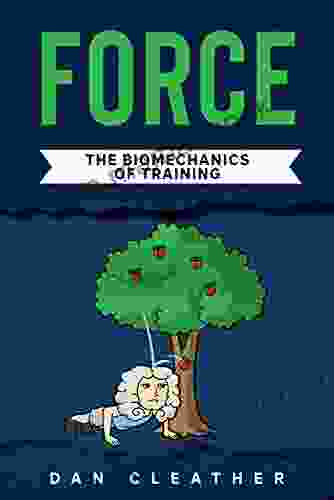Force, Flexibility, and Form: The Biomechanics of Effective Training

In the realm of fitness, the pursuit of optimal performance hinges on a deep understanding of the body's intricate biomechanics. By unraveling the fundamental principles that govern movement, we can fine-tune our training practices and unlock the true potential of our physical capabilities. This article delves into the interplay between force, flexibility, and form, empowering you with the knowledge to optimize your workouts and achieve your fitness aspirations.
4.5 out of 5
| Language | : | English |
| File size | : | 8227 KB |
| Text-to-Speech | : | Enabled |
| Enhanced typesetting | : | Enabled |
| X-Ray | : | Enabled |
| Word Wise | : | Enabled |
| Print length | : | 171 pages |
| Lending | : | Enabled |
| Screen Reader | : | Supported |
Force: The Driving Power of Movement
Force, simply put, is the push or pull exerted by muscles against resistance. It is the driving force that propels our bodies through space. In training, force plays a crucial role in building strength, power, and endurance. Resistance exercises such as weightlifting and bodyweight exercises stimulate muscle fibers to contract and exert force against external loads.
Force production is governed by several factors, including muscle fiber composition, size, and recruitment patterns. Fast-twitch muscle fibers, known for their explosive power, contribute significantly to high-force movements such as sprinting and jumping. Slow-twitch muscle fibers, on the other hand, excel in sustained contractions and lend themselves well to endurance activities like long-distance running.
Flexibility: The Key to Unobstructed Movement
Flexibility refers to the range of motion at a joint or group of joints. Adequate flexibility allows for full and unrestricted movement, enhancing performance and preventing injuries. In training, static stretching exercises, where muscles are held in a stretched position for a prolonged period, are commonly employed to improve flexibility.
Maintaining optimal flexibility is essential for several reasons. It reduces muscle stiffness, which can impede power and speed. It also enhances joint stability by ensuring that the surrounding muscles and ligaments are supple and able to withstand stress. Furthermore, flexibility promotes proper form and technique in exercises, reducing the risk of strain or injury.
Form: The Art of Efficient Movement
Form refers to the specific manner in which an exercise is executed. Proper form involves maintaining correct body alignment, minimizing unnecessary movement, and optimizing muscle activation. It is the foundation of safe and effective training.
Adhering to proper form ensures that targeted muscles are worked effectively, while minimizing strain on supporting structures such as joints and ligaments. It also promotes efficient energy utilization, maximizing the benefits of each exercise and minimizing the risk of fatigue.
The Nexus of Force, Flexibility, and Form
Force, flexibility, and form are not isolated concepts; they are intricately interconnected. Optimal training involves striking a delicate balance between these three elements. Excessive force applied with poor form can lead to injury, while excessive flexibility can compromise stability and power. Conversely, inadequate flexibility can limit force production and hinder proper form.
Effective training requires a holistic approach that considers all three factors. By developing a training program that addresses force, flexibility, and form, you can unlock your full potential and achieve your fitness goals safely and efficiently.
Practical Applications
The principles of force, flexibility, and form can be applied to various training scenarios. Here are a few examples:
- Strength training: Focus on exercises that engage multiple muscle groups, such as squats, deadlifts, and bench presses. Gradually increase resistance to progressively overload muscles and challenge your body.
- Power training: Incorporate explosive movements such as plyometrics (e.g., box jumps, clap push-ups) to develop fast-twitch muscle fibers and enhance power output.
- Endurance training: Engage in activities that sustain muscle contractions for extended periods, such as running, swimming, or cycling. This improves cardiovascular fitness and slow-twitch muscle endurance.
- Flexibility training: Dedicate specific sessions to stretching exercises that target major muscle groups. Hold stretches for at least 30 seconds to promote tissue elongation and increased range of motion.
- Dynamic warm-up: Before workouts, engage in dynamic stretches that mimic the movements of your intended exercises. This prepares your body for the upcoming activity while enhancing flexibility and reducing the risk of injury.
Force, flexibility, and form are the cornerstones of effective training. By understanding the biomechanics that govern these elements, you can design personalized training programs that optimize your workouts and propel you towards your fitness goals. Remember, the journey to fitness is a continuous process that requires patience, consistency, and a commitment to continuous improvement. Embrace the principles of force, flexibility, and form, and watch your body transform into a powerful, resilient, and efficient machine.
4.5 out of 5
| Language | : | English |
| File size | : | 8227 KB |
| Text-to-Speech | : | Enabled |
| Enhanced typesetting | : | Enabled |
| X-Ray | : | Enabled |
| Word Wise | : | Enabled |
| Print length | : | 171 pages |
| Lending | : | Enabled |
| Screen Reader | : | Supported |
Do you want to contribute by writing guest posts on this blog?
Please contact us and send us a resume of previous articles that you have written.
 Top Book
Top Book Novel
Novel Fiction
Fiction Nonfiction
Nonfiction Literature
Literature Paperback
Paperback Hardcover
Hardcover E-book
E-book Audiobook
Audiobook Bestseller
Bestseller Classic
Classic Mystery
Mystery Thriller
Thriller Romance
Romance Fantasy
Fantasy Science Fiction
Science Fiction Biography
Biography Memoir
Memoir Autobiography
Autobiography Poetry
Poetry Drama
Drama Historical Fiction
Historical Fiction Self-help
Self-help Young Adult
Young Adult Childrens Books
Childrens Books Graphic Novel
Graphic Novel Anthology
Anthology Series
Series Encyclopedia
Encyclopedia Reference
Reference Guidebook
Guidebook Textbook
Textbook Workbook
Workbook Journal
Journal Diary
Diary Manuscript
Manuscript Folio
Folio Pulp Fiction
Pulp Fiction Short Stories
Short Stories Fairy Tales
Fairy Tales Fables
Fables Mythology
Mythology Philosophy
Philosophy Religion
Religion Spirituality
Spirituality Essays
Essays Critique
Critique Commentary
Commentary Glossary
Glossary Bibliography
Bibliography Index
Index Table of Contents
Table of Contents Preface
Preface Introduction
Introduction Foreword
Foreword Afterword
Afterword Appendices
Appendices Annotations
Annotations Footnotes
Footnotes Epilogue
Epilogue Prologue
Prologue Meredith Tax
Meredith Tax Lothar Katz
Lothar Katz Jessica Fox
Jessica Fox David Brefield
David Brefield Peter D Matthews
Peter D Matthews Charles Simic
Charles Simic Jennifer Lang Md
Jennifer Lang Md Colin Jost
Colin Jost Cornell Bunting
Cornell Bunting Melanie K Alexander
Melanie K Alexander Mack Wilberg
Mack Wilberg Sharon Moore
Sharon Moore Michael Reisig
Michael Reisig Kathryn Tanner
Kathryn Tanner Andrew W G Rees
Andrew W G Rees Scribes Of Sulterra
Scribes Of Sulterra Cynthia J Cyrus
Cynthia J Cyrus Wolfgang Streeck
Wolfgang Streeck Elizabeth Adan
Elizabeth Adan Tamsyn Muir
Tamsyn Muir
Light bulbAdvertise smarter! Our strategic ad space ensures maximum exposure. Reserve your spot today!

 Jace MitchellThe Eye of the World: Unveiling the Gateway to Robert Jordan's Epic Fantasy...
Jace MitchellThe Eye of the World: Unveiling the Gateway to Robert Jordan's Epic Fantasy...
 Elias MitchellThe Dark Dream: Two Hearts Unite, Conjuring the Magical Hades Knights MC...
Elias MitchellThe Dark Dream: Two Hearts Unite, Conjuring the Magical Hades Knights MC... Willie BlairFollow ·19.8k
Willie BlairFollow ·19.8k Marcel ProustFollow ·19.6k
Marcel ProustFollow ·19.6k Bill GrantFollow ·6.6k
Bill GrantFollow ·6.6k Travis FosterFollow ·2.4k
Travis FosterFollow ·2.4k Jett PowellFollow ·13.2k
Jett PowellFollow ·13.2k Emanuel BellFollow ·18.1k
Emanuel BellFollow ·18.1k Joshua ReedFollow ·3.5k
Joshua ReedFollow ·3.5k Fred FosterFollow ·2.6k
Fred FosterFollow ·2.6k

 David Peterson
David PetersonUnveiling Eleven of the Wheel of Time: A Journey Through...
In the vast and intricate...

 Curtis Stewart
Curtis StewartEbony Jay Rice: A Rising Star in the Entertainment...
Ebony Jay Rice is a force to be reckoned...

 Matt Reed
Matt ReedNavigating Mental Health with Science: Overcoming...
Mental health is an integral part of...

 Guillermo Blair
Guillermo BlairFormer Magistrate's Poetic Reflections on Love and...
In the hallowed halls...

 Corey Green
Corey GreenOf the Dead: William Burroughs' Post-Beat Masterpiece
William S. Burroughs' Of the...
4.5 out of 5
| Language | : | English |
| File size | : | 8227 KB |
| Text-to-Speech | : | Enabled |
| Enhanced typesetting | : | Enabled |
| X-Ray | : | Enabled |
| Word Wise | : | Enabled |
| Print length | : | 171 pages |
| Lending | : | Enabled |
| Screen Reader | : | Supported |










